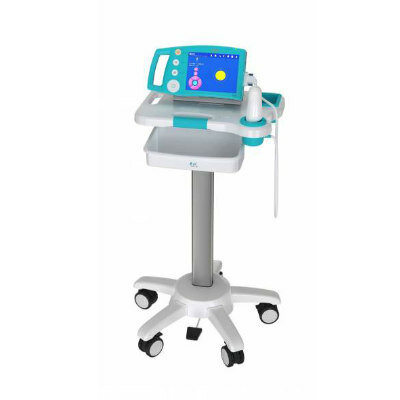AI Uncovers Hidden Heart Disease and Predicts Woman’s Risk for Developing Breast Cancer
|
By MedImaging International staff writers Posted on 12 Dec 2023 |

Recent research has revealed that calcium deposits in the breast's blood vessels are linked to the hardening of cardiovascular arteries. Studies have shown that women with breast arterial calcifications (BAC) face a 51% increased risk of heart disease. Now, new studies have validated the ability of an artificial intelligence (AI) powered solution to uncover hidden heart or vascular diseases as well as predict a woman’s risk for developing breast cancer in the next one- or two years from a single mammogram.
iCAD, Inc. (Nashua, NH, USA) has combined AI with computer-aided detection (AI CAD) in its ProFound Breast Health Suite. This software platform is capable of analyzing a single mammogram to screen for both breast cancer and heart disease, the two leading causes of death in women. ProFound AI not only enhances accuracy and clinical workflow efficiency but also expedites the delivery of results to patients. The software's ability to report on arterial calcification, accompanied by easy-to-comprehend visuals illustrating calcification levels, empowers women to consult with their physicians about their cardiovascular health and any necessary interventions.
A 15-site prospective study, which examined 2D screening mammograms from 15,785 asymptomatic women aged between 20 and 97, found that the ProFound Heart Health AI algorithm accurately detected BAC in mammograms. As anticipated, the prevalence and extent of calcium deposits were found to increase with age. Additionally, in a retrospective study, the ProFound Risk for 2D Mammography tool was evaluated for its effectiveness in identifying women at an elevated risk of developing breast cancer within the following two years, based on subtle changes in their mammograms.
In the second study, ProFound Risk analyzed mammograms of 53,453 women who had received normal results from their radiologists two years earlier. The software identified 42.8% of these women, amounting to 22,878 patients, as being at a higher risk for breast cancer. The predictions made by ProFound Risk were subsequently validated. Women who developed breast cancer within two years of their mammogram were found to have an average risk 2.4 times higher than those who did not develop cancer. Furthermore, the average risk for invasive cancers was higher than for ductal carcinoma in situ (DCIS), a less aggressive cancer form developing in the milk ducts.
“Radiologists currently rely on visual detection of breast arterial calcifications, which is time-consuming and leads to a national underreporting of BAC results in mammography reports,” explained Dr. Chirag Parghi, M.D., chief medical officer of Solis Mammography, and a pioneer in the use of mammography to assess BAC. “Our study suggests that AI can standardize BAC detection on a large scale, speeding up the measurement process and reducing variations between reviewers. By standardizing BAC reporting, AI increases the ease of identifying women that may benefit from additional cardiovascular screening.”
“Our findings suggest AI enables radiologists to identify women who would benefit from more frequent screenings, or suggest supplemental screenings, without leading to overdiagnosis,” said Dr. Axel Gräwingholt, M.D., head of mammography screening at Radiologie am Theater in Germany. “ProFound Risk accurately pinpoints women at high risk for breast cancer while helping us discover small, subtle and aggressive cancers that often go undetected by the naked eye. We believe this technology could greatly enhance the effectiveness of breast cancer screening strategies worldwide.”
Related Links:
iCAD, Inc.
Latest Radiography News
- Novel Breast Imaging System Proves As Effective As Mammography
- AI Assistance Improves Breast-Cancer Screening by Reducing False Positives
- AI Could Boost Clinical Adoption of Chest DDR
- 3D Mammography Almost Halves Breast Cancer Incidence between Two Screening Tests
- AI Model Predicts 5-Year Breast Cancer Risk from Mammograms
- Deep Learning Framework Detects Fractures in X-Ray Images With 99% Accuracy
- Direct AI-Based Medical X-Ray Imaging System a Paradigm-Shift from Conventional DR and CT
- Chest X-Ray AI Solution Automatically Identifies, Categorizes and Highlights Suspicious Areas
- AI Diagnoses Wrist Fractures As Well As Radiologists
- Annual Mammography Beginning At 40 Cuts Breast Cancer Mortality By 42%
- 3D Human GPS Powered By Light Paves Way for Radiation-Free Minimally-Invasive Surgery
- Novel AI Technology to Revolutionize Cancer Detection in Dense Breasts
- AI Solution Provides Radiologists with 'Second Pair' Of Eyes to Detect Breast Cancers
- AI Helps General Radiologists Achieve Specialist-Level Performance in Interpreting Mammograms
- Novel Imaging Technique Could Transform Breast Cancer Detection
- Computer Program Combines AI and Heat-Imaging Technology for Early Breast Cancer Detection
Channels
MRI
view channel
PET/MRI Improves Diagnostic Accuracy for Prostate Cancer Patients
The Prostate Imaging Reporting and Data System (PI-RADS) is a five-point scale to assess potential prostate cancer in MR images. PI-RADS category 3 which offers an unclear suggestion of clinically significant... Read more
Next Generation MR-Guided Focused Ultrasound Ushers In Future of Incisionless Neurosurgery
Essential tremor, often called familial, idiopathic, or benign tremor, leads to uncontrollable shaking that significantly affects a person’s life. When traditional medications do not alleviate symptoms,... Read more
Two-Part MRI Scan Detects Prostate Cancer More Quickly without Compromising Diagnostic Quality
Prostate cancer ranks as the most prevalent cancer among men. Over the last decade, the introduction of MRI scans has significantly transformed the diagnosis process, marking the most substantial advancement... Read moreUltrasound
view channel
Deep Learning Advances Super-Resolution Ultrasound Imaging
Ultrasound localization microscopy (ULM) is an advanced imaging technique that offers high-resolution visualization of microvascular structures. It employs microbubbles, FDA-approved contrast agents, injected... Read more
Novel Ultrasound-Launched Targeted Nanoparticle Eliminates Biofilm and Bacterial Infection
Biofilms, formed by bacteria aggregating into dense communities for protection against harsh environmental conditions, are a significant contributor to various infectious diseases. Biofilms frequently... Read moreNuclear Medicine
view channel
New SPECT/CT Technique Could Change Imaging Practices and Increase Patient Access
The development of lead-212 (212Pb)-PSMA–based targeted alpha therapy (TAT) is garnering significant interest in treating patients with metastatic castration-resistant prostate cancer. The imaging of 212Pb,... Read moreNew Radiotheranostic System Detects and Treats Ovarian Cancer Noninvasively
Ovarian cancer is the most lethal gynecological cancer, with less than a 30% five-year survival rate for those diagnosed in late stages. Despite surgery and platinum-based chemotherapy being the standard... Read more
AI System Automatically and Reliably Detects Cardiac Amyloidosis Using Scintigraphy Imaging
Cardiac amyloidosis, a condition characterized by the buildup of abnormal protein deposits (amyloids) in the heart muscle, severely affects heart function and can lead to heart failure or death without... Read moreGeneral/Advanced Imaging
view channel
New AI Method Captures Uncertainty in Medical Images
In the field of biomedicine, segmentation is the process of annotating pixels from an important structure in medical images, such as organs or cells. Artificial Intelligence (AI) models are utilized to... Read more.jpg)
CT Coronary Angiography Reduces Need for Invasive Tests to Diagnose Coronary Artery Disease
Coronary artery disease (CAD), one of the leading causes of death worldwide, involves the narrowing of coronary arteries due to atherosclerosis, resulting in insufficient blood flow to the heart muscle.... Read more
Novel Blood Test Could Reduce Need for PET Imaging of Patients with Alzheimer’s
Alzheimer's disease (AD), a condition marked by cognitive decline and the presence of beta-amyloid (Aβ) plaques and neurofibrillary tangles in the brain, poses diagnostic challenges. Amyloid positron emission... Read more.jpg)
CT-Based Deep Learning Algorithm Accurately Differentiates Benign From Malignant Vertebral Fractures
The rise in the aging population is expected to result in a corresponding increase in the prevalence of vertebral fractures which can cause back pain or neurologic compromise, leading to impaired function... Read moreImaging IT
view channel
New Google Cloud Medical Imaging Suite Makes Imaging Healthcare Data More Accessible
Medical imaging is a critical tool used to diagnose patients, and there are billions of medical images scanned globally each year. Imaging data accounts for about 90% of all healthcare data1 and, until... Read more
Global AI in Medical Diagnostics Market to Be Driven by Demand for Image Recognition in Radiology
The global artificial intelligence (AI) in medical diagnostics market is expanding with early disease detection being one of its key applications and image recognition becoming a compelling consumer proposition... Read moreIndustry News
view channel
Bayer and Google Partner on New AI Product for Radiologists
Medical imaging data comprises around 90% of all healthcare data, and it is a highly complex and rich clinical data modality and serves as a vital tool for diagnosing patients. Each year, billions of medical... Read more



















